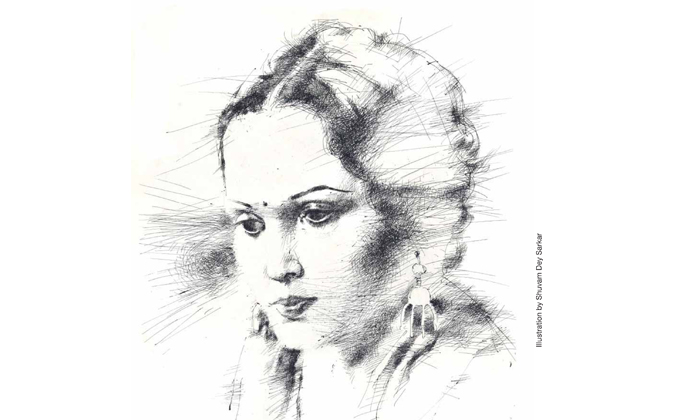Where does one begin? The delightful performances, the quest for love against all odds, the dogged refusal to toe the norm, the studio she helped set up and then nurtured or the 4 minute long kissing scene… For when each of these acts is not just defiance of the times but also a political statement, it is imperative to view her life, not just from a feminist lens but from the prism of India’s struggle for independence. As the nation marched on in protest against the state monopoly on salt, she waged a battle of a different kind, the battle to celebrate her individuality, her desires, her self. Ashapurna Debi writes in her eponymous novel Subornolata, independence is incomplete till women remain shackled to the yoke of patriarchy. At a time when women, only from the margins of society, were supposed to be part of cinema, where the elite class would pigeonhole a female actor as a woman with dubious morals, she not only acted but went on to become the first female superstar of Indian cinema. Yet by no means was she from the edges.
To begin at the beginning, while Devika Rani was the great grand niece of Rabindranath Tagore (from her mother’s side), her father M N Chaudhuri was from no less an illustrious family. He was the first Indian surgeon general of Madras and was also the brother of the renowned author, Pramatha Chaudhuri. Growing up in such a Brahmo cosmopolitan atmosphere, it was natural that Devika would be well educated. Having studied drama at the Royal Academy of Dramatic Art (RADA), she also went on to study architecture, textile and décor design and apprenticed under the legendary Elizabeth Arden. However all these varied interests were actually guiding her towards her destiny- the moving image. A meeting with scriptwriter Niranjan Pal and then with producer and actor, Himangshu Rai and Devika landed in the city of dreams, Bombay. She married Rai in 1929. From then it could have been a comfortable life of domesticity but she put her education to good use in every aspect of cinema. Not just acting but set designing or production management, she had her inputs in all branches of cinema. Soon in close collaboration with Pal, Franz Osten and of course Devika, Rai founded Bombay Talkies in 1934.
These were exciting times in not just the political space of the country. The transition from silent cinema to talkies had proved to be quite lucrative and there was a mad scramble to milch the cow. But besides Prabhat and New Theatres, Bombay Talkies produced cinema that not only entertained but also reflected the embedded class structure, casteism and other social realities. So Achhut Kanya (1936) starring Devika Rani and Ashok Kumar, besides being a riveting love story, was also about the odds a Brahmin faces to unite with his love, an untouchable. And yes, it needs to be stated that it was Devika who introduced Ashok Kumar to Rai. Devika had faith in him, even though Rai had his doubts. Together, they became a golden pair, having starred in eight films together.
The untimely death of Himangshu Rai in 1940 and then some disputes later, Bombay Talkies lost its sheen. But Kismat produced by Devika Rani was a box office success. Gradually, the feeling that she had overstayed her welcome in tinsel town took root and soon Devika Rani gave up all. BUT this is not to say that she had lost her zest for life. As always she was alive to every bend, every possibility and every little surprise it had in store for her. Just as years earlier, she had followed her heart and eloped with her costar Najamul Hussain (only to come back to Rai, to Bombay Talkies, to her passion for the craft), cocking a snook at society’s self appointed hermits, she found love yet again in the Russian artist, Svetoslav Roerich. They married and settled down in Bangalore.
This piece doesn’t intend to be a tribute (even though it might read like one), neither does it intend to give a lowdown of all her achievements (which is why I have consciously skipped many, otherwise vital details). But what it aims at is a celebration of a life, a no holds barred, passionate, whimsical, emotional life in these phony times when actors point out to you, with the subtlety of a sledgehammer, in interview after interview, that they have delivered a ‘historic’ performance by kissing their costars, or by mouthing expletives. Devika Rani did not need these props. She just performed organically, she made love to cinema. As I write this piece, two songs keep playing in a loop in my mind.
One is from Shyam Benegal’s Zubeidaa… “Main Albeli/Ghoomoon Akeli/Koi Paheli Hoon Main” (Though Benegal had quite captured the romance, the madness of the era but it was largely a fictional tale and I wonder when will we have a biopic on Devika Rani, not of the unidimensional, hagiographic kind like Guru or Mangal Pandey but like the throbbing Iris or Frida!)
And the second from Achhut Kanya:
Main ban ki chidiya ban ke ban banboloon re
main ban ka panchi ban ke sang sang doloon re
Main ban ki chidiya ban ke ban ban boloon re
sang sang doloon re…














